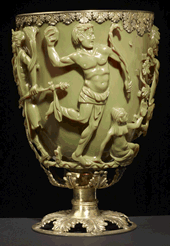Inspired by a marvel of ancient Roman art glass, researchers at the University of Illinois at Urbana-Champaign have designed a device that uses inexpensive light-sensitive plastics to do DNA, drug and protein analysis. The British Museum’s Lycurgus Cup is made out of dichroic glass, glass with added nanoparticles of gold and silver which alter the color of the glass depending on how the light hits it and where the observer stands. The cup looks green in reflected light (light shone directly on it) and red in transmitted light (light shone behind and through it).
Read more....









